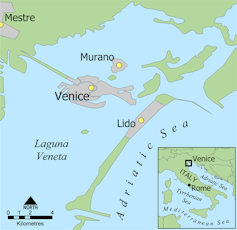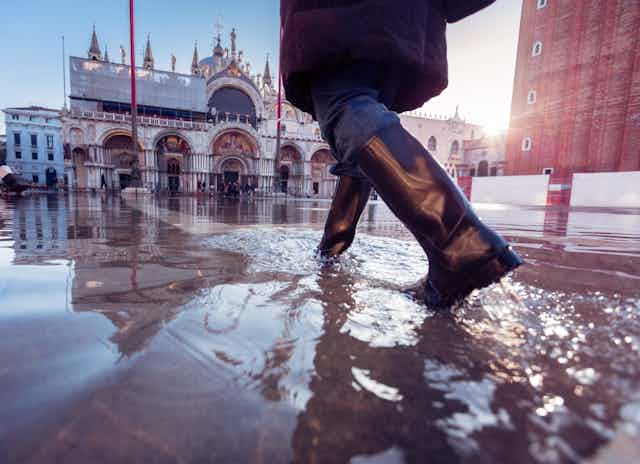The spectacular centrepiece of Venice, St Mark’s Square, now floods more than 60 times a year, up from four times a year in 1900. Recent storms reportedly helped cover over 70% of the city in water, which rose by up to 156cm above its normal level.
Upcoming research conducted with our colleagues at the National Research Centre of Venice (CNR) shows that, without intervention, within 50 years this kind of flooding could occur with nearly every high tide. In fact, some experts have argued that Venice will be gone by the year 2100.
The increase in flooding in Venice is due to the combined effects of land subsidence causing the city to sink, and climate change causing the global sea level to rise. But the city’s chosen solution to the problem, an unfinished scheme of 78 storm gates known as MOSE, is likely to cause damage to the ecological health of the surrounding lagoon and, in the long run, could have no effect on Venice’s preservation.

Venetians have been managing Venice lagoon with engineering since the 12th century. The city is built on 118 small islands drained by a network of canals and located within a tidal lagoon sat between the Italian coast and several barrier islands known as the Murazzi. Interventions have included diverting six major rivers away from the lagoon to stop its waterways filling with silt, rebuilding and extending the Murazzi and reducing the inlets between them from the original nine to three.
Venetians have also combated flooding by periodically raising pavements and walkways and building embankments, but this is no longer possible without damaging the city’s architecture. So in 2003, the MOSE project was launched as a way of protecting Venice from the worsening floods. But the Venetian scientific community is divided over the impact of the project on the lagoon given how much worse the flooding could become.
Records held in the city show the Venice sea level has consistently risen by a total of 26cm since 1870. Around 12cm of that comes from the fact that Venice’s islands are subsiding because of the amount of water removed from the aquifer beneath Venice lagoon. Further measurements show that sea level is still rising 2.4mm a year.
As a result, with a sea level rise of 50cm, the MOSE storm gates will need to close almost daily in order to protect the city from flooding. The problem with this comes from the fact that some of the Venice’s untreated sewage flows directly into the lagoon via the canals and presently is flushed through the inlets into the sea within a week. Shutting the inlets every day could cause increased microbiological pollution and eutrophication in the lagoon. This is where the water becomes so full of nutrients that it spawns excessive growth of plants and algae at the expense of other wildlife.
Lagoon at risk
This would follow other damage to the lagoon’s ecosystem caused by the loss of salt marshes and tidal flats (and the reclamation of tidal flats in other areas for fish farming). Meanwhile, seabed erosion from dredging and illegal clam harvesting has increased the central part of the lagoon’s depth by 50cm since 1970. There are major concerns among the scientific community of Venice that further enclosing and restricting the lagoon will further compromise its ecological health.
The other problem with MOSE is that it doesn’t address the issue of the rising sea level, which is already damaging the city’s buildings with salt and damp, despite widespread renovations of foundations and canals. The conservator of St Mark’s Cathedral has shown that sea water has risen several metres through the church’s foundations walls.

Several alternatives to the MOSE project have been proposed, including pumping water back into the ground to raise the city up, but none have received widespread acceptance by the scientific community. There is agreement that the salt marshes and mudflats that once surrounded Venice should be returned to their former extent in order to preserve the ecological health of the lagoon.
But this will certainly not solve the problem of rising sea levels. If the sea level rises above a sustainable water level there will be no other choice than to permanently cut off the lagoon from the Adriatic Sea. Clearly, this can only be done if the problems of pollution, sewage and port activities have been resolved. In this case we will have a fresh water lagoon, different from the one we know, but preserving the city of Venice within it.


